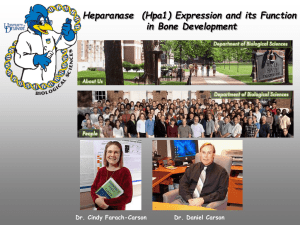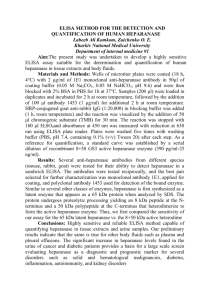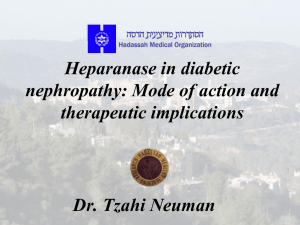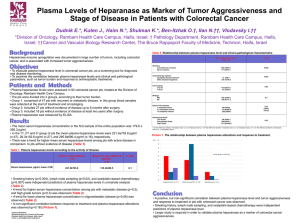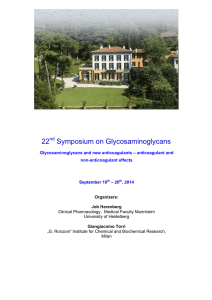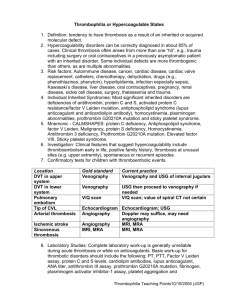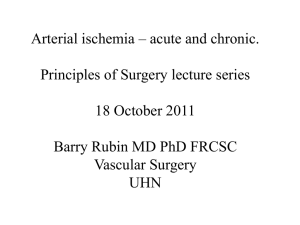Heparanase Regulates Thrombosis in Vascular Injury and Stent-Induced Flow Disturbance Please share
advertisement
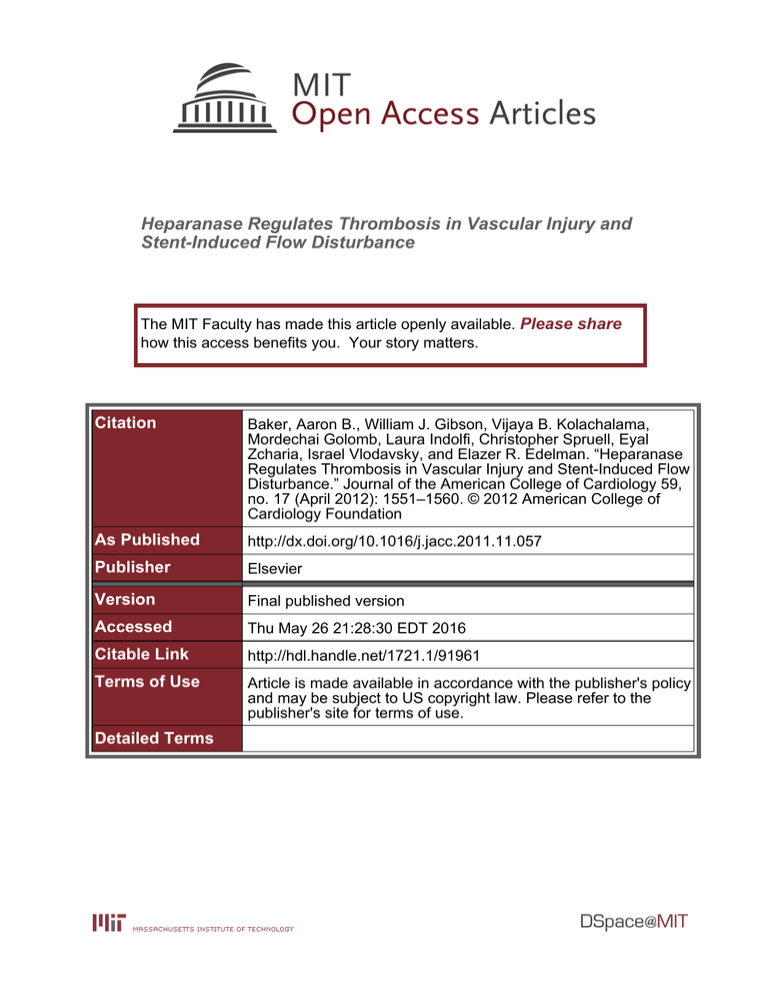
Heparanase Regulates Thrombosis in Vascular Injury and Stent-Induced Flow Disturbance The MIT Faculty has made this article openly available. Please share how this access benefits you. Your story matters. Citation Baker, Aaron B., William J. Gibson, Vijaya B. Kolachalama, Mordechai Golomb, Laura Indolfi, Christopher Spruell, Eyal Zcharia, Israel Vlodavsky, and Elazer R. Edelman. “Heparanase Regulates Thrombosis in Vascular Injury and Stent-Induced Flow Disturbance.” Journal of the American College of Cardiology 59, no. 17 (April 2012): 1551–1560. © 2012 American College of Cardiology Foundation As Published http://dx.doi.org/10.1016/j.jacc.2011.11.057 Publisher Elsevier Version Final published version Accessed Thu May 26 21:28:30 EDT 2016 Citable Link http://hdl.handle.net/1721.1/91961 Terms of Use Article is made available in accordance with the publisher's policy and may be subject to US copyright law. Please refer to the publisher's site for terms of use. Detailed Terms Journal of the American College of Cardiology © 2012 by the American College of Cardiology Foundation Published by Elsevier Inc. Vol. 59, No. 17, 2012 ISSN 0735-1097/$36.00 doi:10.1016/j.jacc.2011.11.057 PRE-CLINICAL RESEARCH Heparanase Regulates Thrombosis in Vascular Injury and Stent-Induced Flow Disturbance Aaron B. Baker, PHD,* William J. Gibson, BS,† Vijaya B. Kolachalama, PHD,† Mordechai Golomb, MD,† Laura Indolfi, PHD,† Christopher Spruell,* Eyal Zcharia, PHD,‡ Israel Vlodavsky, PHD,‡ Elazer R. Edelman, MD, PHD†§ Austin, Texas; Cambridge and Boston, Massachusetts; and Haifa, Israel Objectives The purpose of this study was to examine the role of heparanase in controlling thrombosis following vascular injury or endovascular stenting. Background The use of endovascular stents are a common clinical intervention for the treatment of arteries occluded due to vascular disease. Both heparin and heparan sulfate are known to be potent inhibitors of thrombosis. Heparanase is the major enzyme that degrades heparan sulfate in mammalian cells. This study examined the role of heparanase in controlling thrombosis following vascular injury and stent-induced flow disturbance. Methods This study used mice overexpressing human heparanase and examined the time to thrombosis using a laserinduced arterial thrombosis model in combination with vascular injury. An ex vivo system was used to examine the formation of thrombus to stent-induced flow disturbance. Results In the absence of vascular injury, wild type and heparanase overexpressing (HPA Tg) mice had similar times to thrombosis in a laser-induced arterial thrombosis model. However, in the presence of vascular injury, the time to thrombosis was dramatically reduced in HPA Tg mice. An ex vivo system was used to flow blood from wild type and HPA Tg mice over stents and stented arterial segments from both animal types. These studies demonstrate markedly increased thromboses on stents with blood isolated from HPA Tg mice in comparison to blood from wild type animals. We found that blood from HPA Tg animals had markedly increased thrombosis when applied to stented arterial segments from either wild type or HPA Tg mice. Conclusions Taken together, this study’s results indicate that heparanase is a powerful mediator of thrombosis in the context of vascular injury and stent-induced flow disturbance. (J Am Coll Cardiol 2012;59:1551–60) © 2012 by the American College of Cardiology Foundation Endovascular stenting is a common clinical treatment for arteries with occlusive disease due to atherosclerosis. Whereas this treatment immediately increases blood flow to the ischemic tissue, the vascular injury and indwelling stent material can lead to restenosis of the artery through the development of neointimal hyperplasia. Drug-eluting stent technology has allowed the delivery of therapeutic agents to inhibit the proliferation of vascular cells following stent From the *Department of Biomedical Engineering, University of Texas at Austin, Austin, Texas; †Harvard-MIT Division of Health Sciences and Technology, Massachusetts Institute of Technology, Cambridge, Massachusetts; ‡Cancer and Vascular Biology Research Center, Bruce Rappaport Faculty of Medicine, Technion, Haifa, Israel; and the §Cardiovascular Division, Brigham and Women’s Hospital, Harvard Medical School, Boston, Massachusetts. This study was supported by the American Heart Association through a scientist development grant to Dr. Baker (10SDG2630139), and the generous support of ANSYS Inc. and Tecplot Inc. for providing software licenses. All authors have reported that they have no relationships relevant to the contents of this paper to disclose. Manuscript received January 11, 2010; revised manuscript received October 19, 2011, accepted November 11, 2011. implantation. Although these therapeutics have reduced the incidence of restenosis (1), it has recently become evident that these drugs also inhibit the normal healing of the artery, and this has raised concerns of a prolonged risk of thrombosis in drug-eluting stents (2). The placement of an endovascular stent presents several major stimuli for the formation of thrombosis, including endothelial injury, arterial stretch with deep vascular injury, and locally disturbed blood flow due to the indwelling stent. In this study, we examined the role of heparanase in altering the thrombotic potential of vascular injury and local stent-induced flow disturbance. Heparanase is a -endoglucuronidase that is the major and likely single mammalian enzyme that digests heparan sulfate (3). Heparan sulfate is a glycosaminoglycan that is formed of long, linear repeating disaccharides that have been altered by enzymes in the trans-Golgi to have an intricate pattern of sulfation, epimerization, and acetylation (4). Heparan sulfate’s anticoagulatory properties arise from 1552 Baker et al. Heparanase in Stent Thrombosis the interaction of heparan sulfate with antithrombin III, an inhibitor of coagulation pathway en3-OST ⴝ heparan sulfate zymes, including thrombin and 3-O-sulfotransferase factor Xa (5). This interaction is GP ⴝ glycoprotein analogous to the mechanism of HPA Tg ⴝ heparanase action of heparin (a highly sulfated transgenic analogue of heparan sulfate) and reTF ⴝ tissue factor quires a highly sulfated pentasacvWF ⴝ von Willebrand charide sequence in the polysacfactor charide chain (6). Recent studies WT ⴝ wild type have identified that multiple clinical disorders lead to the excessive production of heparanase. Diabetes and vascular injury have both been found to enhance arterial heparanase expression (7,8). Heparanase itself is increased during neointimal hyperplasia, a process that can be greatly enhanced in the presence of type II diabetes (8). In addition, heparanase expression is elevated in many types of cancers and is critical to the process of metastasis of several cancer types (9). Inflammation also increases both the local and systemic levels of heparanase (10,11). Thus, heparanase overexpression has the potential for mediating disease-induced changes in the thrombotic potential of endovascular stents. Here, we examined the consequences of heparanase overexpression on the thrombotic response to vascular injury and stentinduced flow disturbance. We show that heparanase overexpression does not increase thrombosis in the case of simple endothelial injury but has a profound effect on the thrombotic potential of vascular injury and stent-induced flow disturbance. Together, these results support a critical role for heparanase in controlling in-stent thrombosis. Abbreviations and Acronyms Methods Photochemical injury in genetically modified mice. All studies were approved by the Massachusetts Institute of Technology committee on animal care and conform to the Guide for the Care and Use of Laboratory Animals published by the National Institutes of Health. Transgenic mice overexpressing heparanase were derived from those described previously (12). The mice are transgenic for human heparanase under the control of the constitutively active chicken beta-actin promoter, and overexpress heparanase in all tissues. Mice were anaesthetized with a ketaminexylazine mixture and a Rose Bengal dye solution (10 mg/ml) was injected retro-orbitally into mice at a dosage of 50 mg/kg. An incision was made in the throat of the mouse and the carotid artery of the mouse was then exposed by careful dissection. Animals were randomly assigned to receive no further intervention, 2 forms of local vascular injury (mild and severe), and heparin infusion with the latter. In some instances, the artery was subjected to mild injury in which the forceps were used to lightly compress the artery along its entire length, then 3 passes over the artery were made in which a cotton tip was used to gently JACC Vol. 59, No. 17, 2012 April 24, 2012:1551–60 compress the artery over the forceps. In other samples, the artery was subjected to heavy injury, which used the techniques of light injury with increased force of compression and the additional injury of compressing the artery with forceps across the entire length. After extravascular injury, a flow probe (Transonic, Inc., Ithaca, New York) was placed around the artery and a 2.0-mW laser with a wavelength of 543 nm (ThorLabs Inc., Newton, New Jersey) was applied to the artery. Blood flow was monitored until an occlusive thrombus was formed that stopped flow for at least 2 min. Histological characterization of injury. The carotid artery was exposed in the mice, treated with injury, and then the aorta was cannulated and the mouse perfused with 4 ml of saline with heparin. The mice were then perfused with a 2% glutaraldehyde solution. The carotid was tied with a suture at the proximal end, excised, and stored in 2% glutaraldehyde overnight. The vessels were then cryoprotected with progressive infiltration of sucrose solutions (final concentration of 30% sucrose), embedded in optimal cutting temperature compound, and cryosectioned. Cryosections were cut and standard methods were used to stain hematoxylin and eosin or an elastin Verhoeff–van Giesen stain (Electron Microscopy Sciences, Hatfield, Pennsylvania). Flow loop model of stent thrombosis. Mice were anesthetized and blood was collected through a 20-gauge needle inserted into the left ventricle. The collected blood was anticoagulated using a 10% acid citrate dextrose solution (composed of 85 mmol/l trisodium citrate, 69 mmol/l citric acid, and 111 mmol/l glucose; pH 4.6). The anticoagulated blood was then pooled into wild type (WT) and heparanase transgenic (HPA Tg) groups. The thrombosis model used in this study is a modified Chandler loop that has been described previously (13). It employs pulsatile flow profiles with Reynolds and Wormsely numbers matched to physiological conditions. The loops are composed of silicon tubing (3.2 mm inside diameter/4.8 mm outside diameter), with a reactive portion that was coated with collagen and stented using NIR Elite stents (9 mm ⫻ 3 mm; Boston Scientific, Inc., Natick, Massachusetts). In some cases, a mouse aorta was stented into the reactive section of the artery. Blood from mice was injected into flow loops using a 21-gauge needle and the flow was maintained for 10 min. Blood was then collected in ethylenediamine tetraacetic acid containing collection vials and the reactive portion of the flow loop was flushed with Tyrode solution to remove nonadherent clot and cellular debris. Stented segments were stored in 10% neutral buffered formalin until further analysis. To analyze the thrombogenicity of flow loop samples, photographs of the segments were first taken of each segment followed by a measurement of optical density. Optical density measurements were performed on the remaining nonaorta samples (n ⫽ 6) to determine the red fibrin content of the clot. The samples were placed in a cuvette and absorbance was measured at 405 nm. Background signal from the silicone tubing was subtracted from all measurements. The samples were then incubated with Baker et al. Heparanase in Stent Thrombosis JACC Vol. 59, No. 17, 2012 April 24, 2012:1551–60 0.5% uranyl acetate for 30 min, washed 3 times in deionized water, and visualized with an environmental scanning electron microscope (Philips/FEI XL30 FEG-SEM, Hillsboro, Oregon) in backscattering mode. Mathematical modeling of flow over stent. Computational modeling of flow over the stent was performed as described in the Online Appendix. Statistical analysis. All results are shown as mean ⫾ SE of the mean. Comparisons between only 2 groups were performed using a 2-tailed Student t test. Differences were considered significant at p ⬍ 0.05. Multiple comparisons between groups were analyzed by 2-way analysis of variance followed by a Tukey post hoc test. A 2-tailed probability value ⬍0.05 was considered statistically significant. Results Heparanase overexpression increases thrombosis following vascular injury and is neutralized with heparin treatment. Vascular injury is a potent stimulus for thrombus formation and a potential design limitation of endovascular stents. We used a photochemical injury model in combination with extravascular injury to understand the role of heparanase in controlling thrombosis in response to vascular injury. In this model, the animals were given rose bengal dye and a laser was applied to the carotid artery (Fig. 1A). The A laser activated the dye causing oxidative damage to the endothelium and eventually leading to thrombosis. The time to thrombosis was used as a measurement of the thrombogenicity of the artery. To quantify the effects of crush injury on arterial morphology, we injured the carotid arteries of mice and examined them histologically. This analysis demonstrated a minimal effect of injury with the light injury protocol but demonstrated stretch injury of the elastic laminae with the heavy injury protocol (Fig. 1B). Neither protocol led to fracture of the elastic laminae as evidenced with elastin Verhoeff–van Giesen staining. In uninjured arteries, the time to thrombosis was similar for both WT and HPA Tg mice (Fig. 2A). With mild injury, there was an approximately 40% decrease in time to thrombosis (Fig. 2B). With more severe injury, there was similar decrease in the time-to-thrombus formation (Fig. 2C). This effect was neutralized by the pre-treatment of the mice with heparin prior to heavy injury and photochemically induced thrombosis (Figs. 2C and 2D). As a control for these studies, we examined the effects of anesthesia and extravascular injury on levels of heparanase expression (Online Fig. 1). We performed detailed histological analysis on the in situ thrombi (Online Fig. 2). The thrombi formed in the flow loop appeared to be principally fibrin-based with increased platelets in the heparanase overexpressing animals. The in situ thrombi appeared to be more platelet-based. Laser λ=543 nm Mouse Flow probe Flowmeter B Uninjured Light Injury Heavy Injury H&E Elastin Figure 1 1553 Photochemical Thrombosis Model Experimental Setup and Histological Characterization of Arterial Injury (A) Experimental setup for photochemical injury model. (B) Histological staining of arteries that were treated with mild or heavy injury. Scale bar ⫽ 50 m. H&E ⫽ hematoxylin and eosin stain. 1554 Baker et al. Heparanase in Stent Thrombosis JACC Vol. 59, No. 17, 2012 April 24, 2012:1551–60 A B 80 80 Clot Time (minutes) Clot Time (minutes) 100 60 40 20 0 No Heparin Heparin 60 * 40 20 WT HPA Tg D 1.2 HPA Tg WT 1.0 0.8 0.6 0.4 0.2 0.0 0 WT Figure 2 20 HPA Tg Relative Flow Clot Time (minutes) 80 * 40 0 WT C 60 HPA Tg 0 20 40 60 Time (min) Heparanase Overexpression Leads to Increased Thrombosis in the Presence of Vascular Injury (A) Time to occlusion for uninjured arteries was similar in both wild type (WT) (n ⫽ 8) and heparanase transgenic (HPA Tg) (n ⫽ 6) mice. (B) Thrombosis in the HPA Tg mice occurred faster than in WT in the presence of mild injury (n ⫽ 5). *p ⬍ 0.05. (C) Heparin neutralized the prothrombotic effects of heparanase overexpression in mice subjected to heavy arterial injury (n ⫽ 4 to 6). (D) A representative flow trace from thrombosis after heavy arterial injury. Flow over stents in an ex vivo flow system creates low shear stress regions near stent struts and recirculation zones near stent strut intersections. Stenting induces a complex flow disturbance within the artery. Stent-induced flow profiles are complex and can be highly thrombogenic (14). We used a computational model to characterize the blood flow within our ex vivo flow system. In these simulations, we created a 3-dimensional computational model of the NIR Elite stent geometry and simulated the flow over 1 pulsatile cycle of flow. The wall shear stress around the stent is shown in Figure 3A. Regions of low wall shear stress are locations that may be of higher risk for thrombosis. Of particular interest were regions in which there was flow reversal and complex recirculation zones (15). These zones of recirculation were found in regions where the stent struts intersected (Fig. 3A). Examining the results of the circulation analysis demonstrated recirculation zones both upstream and downstream of the stent struts (Fig. 3A). Two lines were drawn longitudinally through the stent and the shear stress plotted along these lines representing the average shear stress profiles along the stent at the top (Fig. 3B) and bottom (Fig. 3C) of the upper panels of Figure 3A. An analogous model for the 2-dimensional flow over a single stent strut demonstrated a significantly larger recirculation zone downstream from the strut (Fig. 3D). Heparanase overexpression increases thrombosis around stents and in stented arterial segments. To examine the effects of heparanase overexpression on the formation of thrombus in response to stent-induced flow disturbance, we applied blood flow to stents in an ex vivo pulsatile flow system. The system allows the passage of blood over stent and has been validated as having a physiological flow profile (13). We first flowed blood from WT or HPA Tg mice over bare-metal stents ex vivo. After 10 min of pulsatile flow, we examined the stents macroscopically and found visible thrombus formation on stents treated with HPA Tg blood but not on stents treated with WT blood (Fig. 4A). We measured the absorbance of light at a wavelength of 405 nm as a measure of fibrin deposition and found it was increased by nearly 3-fold with HPA Tg versus WT blood (Fig. 4B). Stents without arterial segments were stained and examined using environmental scanning electron microscopy for the formation of microscopic thrombi. HPA Tg blood formed increased thrombosis after 10 min of flow, leading to a 3-fold increase in fibrin coverage of the stents and a dramatic increase in interstrut fibrin content (Figs. 5A and 5B). Maximal thrombus formation occurred in regions predicted to have disturbed flow by our computational model. A comparison of the mathematical model of the recirculation zone found a similar distribution of fibrin deposition with regions of recirculating flow (Fig. 5A). Thrombosis in vascular injury is ultimately controlled by the inherent thrombogenic potential of blood components and the thrombogenicity of the injured arterial wall. In conventional models of thrombosis, it is difficult to examine the effects of blood versus those of the arterial wall. To address this issue, we developed an ex vivo thrombosis model in which a stent is Baker et al. Heparanase in Stent Thrombosis JACC Vol. 59, No. 17, 2012 April 24, 2012:1551–60 1555 A B C 5.5 4.5 4.5 3.5 2.5 1.5 0.5 -0.5 0.0 D 6.5 5.5 Shear Stress (Pa) Shear Stress (Pa) 6.5 3.5 2.5 1.5 0.5 0.2 0.4 0.6 0.8 1.0 -0.5 0.0 0.2 Position Figure 3 0.4 0.6 0.8 1.0 Position Computational Model of the Blood Flow and Wall Shear Stress for a Stent Within the Ex Vivo Flow System (A) For the shear stress plots, the gradient of colors represents varying levels of average shear stress over the stent. Legend represents wall shear stress (in Pascals). (B, C) Plot of the wall shear stress on a longitudinal line passing through the stent struts from the top of the stent (B) and bottom of the stent (C). (D) A cross section through a stent strut positioned against the arterial wall. This plot demonstrates the regions of flow reversal both proximal and distal to the stent strut. The blood flow in this simulation proceeds from left to right in the diagram. Legend represents flow velocity (m/s). implanted in the aorta of a mouse while inside a silicone tube. The tube is then mounted into an ex vivo system allowing blood to be passed over the arterial segment and stent. We performed this assay on WT and HPA Tg animals, including an analysis of HPA Tg blood flowing over stented WT arterial segments and vice versa (Figs. 6A and 6B). This analysis revealed fairly minimal thrombus formation in WT blood– treated stents implanted in either HPA Tg or WT aortas but a dramatic increase in thrombosis with HPA Tg blood. The combination of HPA Tg blood and aorta was found to have the most thrombosis. A similar analysis was performed on stented arterial subsegments. Interestingly, the thrombus formation occurred in samples with HPA Tg blood and either WT or HPA Tg aorta. These results indicated that heparanase expression in the blood had a more profound effect on the thrombotic potential of the implanted stent. 1556 Baker et al. Heparanase in Stent Thrombosis JACC Vol. 59, No. 17, 2012 April 24, 2012:1551–60 A WT Blood HPA Tg Blood B Relative Optical Density (405 nm) No Aorta * 3.5 3.0 2.5 2.0 1.5 1.0 0.5 0.0 WT C WT Blood HPA Tg HPA Tg Blood WT Aorta HPA Aorta Figure 4 Heparanase Overexpression Increases the Thrombotic Potential of Stents in an Ex Vivo Flow System (A) Photographs of the stented tubes and arterial subsegments after 10 min of pulsatile flow (n ⫽ 3). (B) Optical density of the clots formed on stents implanted without aortae demonstrates significantly more clot burden on HPA Tg samples (n ⫽ 3). (C) In the other samples, stents were implanted in the aorta of WT (n ⫽ 6) and HPA Tg mice (n ⫽ 4) and blood was flowed over the stented aortic segments within the ex vivo flow system. *p ⬍ 0.05 versus WT samples. Abbreviations as in Figure 2. Discussion The Virchow triad of risk factors for thrombosis includes hypercoagulability of the blood, alterations in hemodynamics, and endothelial/vessel wall injury. Endovascular interventions can induce each of these factors, and thrombosis is again emerging as a critical rate-limiting factor in stent- based therapy. Whatever endothelium may be resident in diseased vessels is rapidly lost with the placement of endovascular devices (16), with accompanying arterial stretch and deeper vascular injury forms as well. The plastic deformation of the vessel and protrusion of the resident devices into the flow stream creates alterations in the local hemodynamics (17,18). Baker et al. Heparanase in Stent Thrombosis JACC Vol. 59, No. 17, 2012 April 24, 2012:1551–60 1557 A WT HPA Recirc. Model B 80 Fibrin Coverage (%) 60 40 20 0 * 60000 50000 40000 30000 20000 10000 0 WT Figure 5 Inter-Strut Fibrin Area (µm2) 70000 * HPA Tg WT HPA Tg Heparanase Overexpression Increases Thrombus Formation on Stents in Regions of Flow Reversal (A) Environmental scanning electron microscopy micrographs of stents reveal increased thrombosis with HPA Tg blood in comparison to WT blood. High clot burden was observed in areas of flow reversal predicted by a computational model. Bar ⫽ 100 m. (B) Quantitative analysis of the thrombus area on the stent and between the stent struts demonstrated markedly increased thrombosis in the HPA Tg group. *p ⬍ 0.05 versus WT samples. Abbreviations as in Figure 2. We now demonstrate the powerful potential of combining even modest alterations of systemic hypercoagulability in concert with these other local factors to stimulate thrombosis. We also extend emerging data on the complex enzymatic, physiologic regulation of heparan sulfate biochemistry in vascular biology. Previous studies have supported that heparan sulfate proteoglycans can inhibit thrombosis in response to deep vascular injury (19). In this study, we have demonstrated that heparanase enhances the thrombotic potential of the injured artery and thrombosis in response to the flow disturbances caused by endovascular stents. Previous studies have demonstrated that heparanase overexpression induces increased levels of tissue factor (TF) through a p38-dependent signaling pathway (20). In parallel, heparanase also appears to stimulate TF pathway inhib- itor (21). Additionally, exogenously applied heparanase has been shown to modify in vitro coagulation on endothelial cells in culture (20,22). Mice overexpressing heparanase also have a mildly shortened activated partial thromboplastin time (22). Previous studies have found that heparanase could neutralize the anticoagulant activity of unfractionated heparin activity (23). However, enzymatically inactive heparanase (proenzyme) did not have an effect on heparanaseactivated partial pro-thrombin time or platelet aggregation. Recent reports have also suggested that heparanase may act through alteration of TF and activated factor X (24,25). Together these results suggest that heparanase has only a moderate effect on the hypercoagulability of the blood (overexpression of TF with compensation by TF pathway inhibitor). Our studies are in agreement with these findings Baker et al. Heparanase in Stent Thrombosis 1558 A JACC Vol. 59, No. 17, 2012 April 24, 2012:1551–60 WT Blood WT Blood HPA Tg Blood HPA Tg Blood WT Aorta B Figure 6 Relative Inter-Strut Adherent Cell Density HPA Aorta 30 ** 25 20 15 * 10 5 0 AW BW AHBW Blood: WT WT HPA AW BH HPA AHBH Aorta: WT HPA WT HPA Heparanase Increased the Adherence of Cells From the Blood Within Stented Arterial Segments (A) Environmental scanning electron microscopy reveals increased adherence of blood cells in samples treated with blood from HPA Tg mice. Bar ⫽ 50 m. (B) A quantitative analysis of cellular adhesion and clot formation in the stented arterial segments (n ⫽ 3). *p ⬍ 0.05 versus both WT blood samples. **p ⬍ 0.05 versus all other samples. Abbreviations as in Figure 2. as there was no difference between the clotting times of WT and HPA Tg mice in the absence of vascular injury. In stents implanted in silicone tubing, we found that blood from heparanase overexpressing mice had a nearly 3-fold increase in thrombin deposition. This would imply that in response to the altered hemodynamic environment provided by the stents, heparanase overexpression increases thrombus formation. Notably, the decrease in time to thrombus formation was neutralized by the pre-treatment of mice with heparin. This is primarily attributed to the antithrombotic effect of heparin and possibly also to its potent heparanase-inhibiting activity (26). In areas of high shear rates, clot formation on implanted devices and the subendothelium is highly dependent on the von Willebrand factor (vWF) (27). Two platelet receptors bind to vWF including glycoprotein (GP) Ib and GP IIb/IIIa (28,29). Both are essential for the thrombus formation under high shear rates with GP Ib mediating initial platelet adhesion and GP IIb/IIIa binding after platelet activation (30). Heparin binds vWF and blocks the interaction with GP Ib (31). Thus, loss of endogenous heparan sulfate could increase vWF-GP Ib interactions, facilitating clot formation around and in the flow surrounding stent struts. Factor VIII binds to vWF in a noncovalent association and this complex can be internalized by cells and degraded through low-density lipoprotein receptor-related protein in a heparan sulfate– dependent manner (32). Heparanase has been shown to increase the shedding of the cell surface heparan sulfate proteoglycan syndecan-1 (33,34). Thus, shedding of cell surface heparan sulfate proteoglycans due to heparanase excess and alterations in factor VIII degradation may also contribute to the increased thrombosis observed in our studies. To examine the relative effects of heparanase overexpression on the wall and blood components separately, we implanted stents in aortae enclosed in silicone tubing and applied blood flow. The results demonstrated that the combination of blood and aorta from mice overexpressing heparanase led to the greatest extent of stent thrombosis. If the heparanase overexpressing blood was applied to a stent in a WT aorta, about one-third of the thrombosis was Baker et al. Heparanase in Stent Thrombosis JACC Vol. 59, No. 17, 2012 April 24, 2012:1551–60 formed. However, when WT blood was applied to either the WT aorta or heparanase overexpressing aorta, the thrombosis formation was greatly reduced. These results suggest that heparanase overexpression in the blood has a powerful effect on the thrombotic potential of implanted endovascular stents. This potential can be reduced if there is normal heparanase expression in the vessel and is even more reduced if normal levels of heparanase expression are maintained in the blood. Clinically, heparanase levels are increased in the plasma of cancer patients by 2- to 5-fold depending on the severity and treatment of the cancer (35). In addition, heparanase is elevated in patients with diabetes, renal diseases, colitis, rheumatoid arthritis, and atherosclerotic lesions (11,36,37). Platelets contain large amounts of heparanase in their ␣ granules, yet its function has not been elucidated. Clearly, activated platelets provide a major source for plasma heparanase, as do neutrophils and other cells of immune system (38), and activated vascular endothelial cells (9). Notably, large amounts of heparanase are found in wound fluid (39) and the synovial fluid of rheumatoid arthritis patients (36). We have recently demonstrated that heparanase expression is augmented in the neointima formed after stent implantation in diabetic animals and that heparanase regulates the formation of neointimal hyperplasia following vascular injury (7). Both patients with diabetes and end-stage renal disease have increased risk of stent thrombosis (40), and our results suggest that heparanase expression may be a contributing factor to this clinical finding. In the absence of vascular injury, we found no difference in the clotting times in the laser-induced injury model in heparanase overexpressing mice. The laser-induced injury model causes oxidative damage to the endothelium leading to thrombosis (41). This model produces endothelial injury in the absence of altered hemodynamics and hypercoagulability. In this context, our studies support the theory that, in terms of baseline endothelial injury or dysfunction, overexpression of heparanase has little effect on thrombosis. Endogenous heparan sulfate has been widely considered to have anticoagulatory properties (42); however, some studies have questioned the role of heparan sulfate in normal hemostasis (43). Our findings are consistent with previous studies that examined the role of heparan sulfate 3-O-sulfotransferase-1 (3OST-1) on thrombosis in mice (44). Three-OST-1 is the rate-limiting enzyme for the formation of antithrombin binding motifs in heparan sulfate. Knockout of 3-OST-1 in mice leads to the loss of the majority of anticoagulant heparan sulfate but did not alter thrombosis time in a FeCl3-induced thrombosis model (44). Heparanase overexpressing mice demonstrate increased heparan sulfate degradation (12). In particular, heparanase can cut the antithrombin binding motif within heparan sulfate (45). Thus, the results on 3-OST-1 and our results are consistent with the notion that in a vessel with simple endothelial injury, heparan sulfate does not play a critical role in preventing thrombosis. 1559 Taken together, our results demonstrate that heparanase has a profound impact on the thrombotic response to endovascular stenting. In context of the Virchow triad of thrombotic risk factors, we have shown that heparanase alters the thrombotic potential of flow-induced changes and the inherent hypercoagulability of the blood during vascular injury, but that it has little effect in the case of endothelial injury without accompanying deeper arterial injury. Many clinically relevant disorders such as diabetes and cancer can increase both blood and tissue levels of heparanase (46 – 48). Clinical studies have also suggested that comorbidity with cancer is a potential risk factor for stent thrombosis (49). Our work supports the theory that heparanase excess in both the blood and arterial tissue work synergistically to make endovascular stent implantation highly thrombogenic. Consequently, our studies imply that heparanase inhibitors may provide augmentation to traditional anticoagulatory therapies and reduce the risk of thrombotic events in patients with elevated levels of heparanase due to diabetes, cancer, or other diseases. Reprint requests and correspondence: Dr. Aaron B. Baker, Department of Biomedical Engineering, University of Texas at Austin, 1 University Station, BME 5.202D, C0800, Austin, Texas 78712. E-mail: abbaker1@gmail.com. REFERENCES 1. Moses JW, Leon MB, Popma JJ, et al., for the SIRIUS Investigators. Sirolimus-eluting stents versus standard stents in patients with stenosis in a native coronary artery. N Engl J Med 2003;349:1315–23. 2. Daemen J, Wenaweser P, Tsuchida K, et al. Early and late coronary stent thrombosis of sirolimus-eluting and paclitaxel-eluting stents in routine clinical practice: data from a large two-institutional cohort study. Lancet 2007;369:667–78. 3. Vlodavsky I, Goldshmidt O, Zcharia E, et al. Mammalian heparanase: involvement in cancer metastasis, angiogenesis and normal development. Semin Cancer Biol 2002;12:121–9. 4. Hacker U, Nybakken K, Perrimon N. Heparan sulphate proteoglycans: the sweet side of development. Nat Rev Mol Cell Biol 2005;6: 530 – 41. 5. Marcum JA, Rosenberg RD. Heparinlike molecules with anticoagulant activity are synthesized by cultured endothelial cells. Biochem Biophys Res Commun 1985;126:365–72. 6. Thunberg L, Backstrom G, Lindahl U. Further characterization of the antithrombin-binding sequence in heparin. Carbohydr Res 1982;100: 393– 410. 7. Baker AB, Groothuis A, Jonas M, et al. Heparanase alters arterial structure, mechanics, and repair following endovascular stenting in mice. Circ Res 2009;104:380 –7. 8. Katz A, Van-Dijk DJ, Aingorn H, et al. Involvement of human heparanase in the pathogenesis of diabetic nephropathy. Isr Med Assoc J 2002;4:996 –1002. 9. Ilan N, Elkin M, Vlodavsky I. Regulation, function and clinical significance of heparanase in cancer metastasis and angiogenesis. Int J Biochem Cell Biol 2006;38:2018 –39. 10. Edovitsky E, Lerner I, Zcharia E, Peretz T, Vlodavsky I, Elkin M. Role of endothelial heparanase in delayed-type hypersensitivity. Blood 2006;107:3609 –16. 11. Waterman M, Ben-Izhak O, Eliakim R, Groisman G, Vlodavsky I, Ilan N. Heparanase upregulation by colonic epithelium in inflammatory bowel disease. Mod Pathol 2007;20:8 –14. 12. Zcharia E, Metzger S, Chajek-Shaul T, et al. Transgenic expression of mammalian heparanase uncovers physiological functions of heparan 1560 13. 14. 15. 16. 17. 18. 19. 20. 21. 22. 23. 24. 25. 26. 27. 28. 29. 30. 31. 32. Baker et al. Heparanase in Stent Thrombosis sulfate in tissue morphogenesis, vascularization, and feeding behavior. FASEB J 2004;18:252– 63. Kolandaivelu K, Edelman ER. Low background, pulsatile, in vitro flow circuit for modeling coronary implant thrombosis. J Biomech Eng 2002;124:662– 8. Beythien C, Terres W, Hamm CW. In vitro model to test the thrombogenicity of coronary stents. Thromb Res 1994;75:581–90. Duraiswamy N, Cesar JM, Schoephoerster RT, Moore JE Jr. Effects of stent geometry on local flow dynamics and resulting platelet deposition in an in vitro model. Biorheology 2008;45:547– 61. Rogers C, Edelman ER. Endovascular stent design dictates experimental restenosis and thrombosis. Circulation 1995;91:2995–3001. Balakrishnan B, Tzafriri AR, Seifert P, Groothuis A, Rogers C, Edelman ER. Strut position, blood flow, and drug deposition: implications for single and overlapping drug-eluting stents. Circulation 2005;111:2958 – 65. Hwang CW, Wu D, Edelman ER. Impact of transport and drug properties on the local pharmacology of drug-eluting stents. Int J Cardiovasc Intervent 2003;5:7–12. Nugent MA, Nugent HM, Iozzo RV, Sanchack K, Edelman ER. Perlecan is required to inhibit thrombosis after deep vascular injury and contributes to endothelial cell-mediated inhibition of intimal hyperplasia. Proc Natl Acad Sci U S A 2000;97:6722–7. Nadir Y, Brenner B, Zetser A, et al. Heparanase induces tissue factor expression in vascular endothelial and cancer cells. J Thromb Haemost 2006;4:2443–51. Nadir Y, Brenner B, Gingis-Velitski S, et al. Heparanase induces tissue factor pathway inhibitor expression and extracellular accumulation in endothelial and tumor cells. Thromb Haemost 2008;99: 133– 41. Nadir Y, Vlodavsky I, Brenner B. Heparanase, tissue factor, and cancer. Semin Thromb Hemost 2008;34:187–94. Nadir Y, Brenner B. Heparanase procoagulant effects and inhibition by heparins. Thromb Res 2010;125 Suppl 2:S72– 6. Katz BZ, Muhl L, Zwang E et al. Heparanase modulates heparinoids anticoagulant activities via non-enzymatic mechanisms. Thromb Haemost 2007;98:1193–9. Nadir Y, Brenner B, Fux L, Shafat I, Attias J, Vlodavsky I. Heparanase enhances the generation of activated factor X in the presence of tissue factor and activated factor VII. Haematologica 2010;95:1927–34. Vlodavsky I, Ilan N, Nadir Y et al. Heparanase, heparin and the coagulation system in cancer progression. Thromb Res 2007;120 Suppl 2:S112–20. Olson JD, Zaleski A, Herrmann D, Flood PA. Adhesion of platelets to purified solid-phase von Willebrand factor: effects of wall shear rate, ADP, thrombin, and ristocetin. J Lab Clin Med 1989;114:6 –18. De Marco L, Girolami A, Russell S, Ruggeri ZM. Interaction of asialo von Willebrand factor with glycoprotein Ib induces fibrinogen binding to the glycoprotein IIb/IIIa complex and mediates platelet aggregation. J Clin Invest 1985;75:1198 –203. Ikeda Y, Handa M, Kawano K, et al. The role of von Willebrand factor and fibrinogen in platelet aggregation under varying shear stress. J Clin Invest 1991;87:1234 – 40. Peterson DM, Stathopoulos NA, Giorgio TD, Hellums JD, Moake JL. Shear-induced platelet aggregation requires von Willebrand factor and platelet membrane glycoproteins Ib and IIb-IIIa. Blood 1987;69: 625– 8. Poletti LF, Bird KE, Marques D, Harris RB, Suda Y, Sobel M. Structural aspects of heparin responsible for interactions with von Willebrand factor. Arterioscler Thromb Vasc Biol 1997;17:925–31. Sarafanov AG, Ananyeva NM, Shima M, Saenko EL. Cell surface heparan sulfate proteoglycans participate in factor VIII catabolism JACC Vol. 59, No. 17, 2012 April 24, 2012:1551–60 33. 34. 35. 36. 37. 38. 39. 40. 41. 42. 43. 44. 45. 46. 47. 48. 49. mediated by low density lipoprotein receptor-related protein. J Biol Chem 2001;276:11970 –9. Mahtouk K, Hose D, Raynaud P, et al. Heparanase influences expression and shedding of syndecan-1, and its expression by the bone marrow environment is a bad prognostic factor in multiple myeloma. Blood 2007;109:4914 –23. Yang Y, Macleod V, Miao HQ et al. Heparanase enhances syndecan-1 shedding: a novel mechanism for stimulation of tumor growth and metastasis. J Biol Chem 2007;282:13326 –33. Shafat I, Barak AB, Postovsky S, et al. Heparanase levels are elevated in the plasma of pediatric cancer patients and correlate with response to anticancer treatment. Neoplasia 2007;9:909 –16. Li RW, Freeman C, Yu D, et al. Dramatic regulation of heparanase activity and angiogenesis gene expression in synovium from patients with rheumatoid arthritis. Arthritis Rheum 2008;58:1590 – 600. van den Hoven MJ, Rops AL, Vlodavsky I, Levidiotis V, Berden JH, van der Vlag J. Heparanase in glomerular diseases. Kidney Int 2007;72:543– 8. Vlodavsky I, Eldor A, Haimovitz-Friedman A, et al. Expression of heparanase by platelets and circulating cells of the immune system: possible involvement in diapedesis and extravasation. Invasion Metastasis 1992;12:112–27. Zcharia E, Zilka R, Yaar A, et al. Heparanase accelerates wound angiogenesis and wound healing in mouse and rat models. FASEB J 2005;19:211–21. Iakovou I, Schmidt T, Bonizzoni E, et al. Incidence, predictors, and outcome of thrombosis after successful implantation of drug-eluting stents. JAMA 2005;293:2126 –30. Rosen ED, Raymond S, Zollman A, et al. Laser-induced noninvasive vascular injury models in mice generate platelet- and coagulationdependent thrombi. Am J Pathol 2001;158:1613–22. Hallgren J, Spillmann D, Pejler G. Structural requirements and mechanism for heparin-induced activation of a recombinant mouse mast cell tryptase, mouse mast cell protease-6: formation of active tryptase monomers in the presence of low molecular weight heparin. J Biol Chem 2001;276:42774 – 81. Weitz JI. Heparan sulfate: antithrombotic or not? J Clin Invest 2003;111:952– 4. HajMohammadi S, Enjyoji K, Princivalle M, et al. Normal levels of anticoagulant heparan sulfate are not essential for normal hemostasis. J Clin Invest 2003;111:989 –99. Gong F, Jemth P, Escobar Galvis ML, et al. Processing of macromolecular heparin by heparanase. J Biol Chem 2003;278:35152– 8. Baker AB, Chatzizisis YS, Beigel R, et al. Regulation of heparanase expression in coronary artery disease in diabetic, hyperlipidemic swine. Atherosclerosis 2010;213:436 – 42. Shafat I, Ilan N, Zoabi S, Vlodavsky I, Nakhoul F. Heparanase levels are elevated in the urine and plasma of type 2 diabetes patients and associate with blood glucose levels. PloS One 2011;6:e17312. Vlodavsky I, Beckhove P, Lerner I, et al. Significance of heparanase in cancer and inflammation. Cancer Microenviron 2011 Aug 3 [E-pub ahead of print]. Hobson AR, McKenzie DB, Kunadian V, et al. Malignancy: an unrecognized risk factor for coronary stent thrombosis? J Invasive Cardiol 2008;20:E120 –3. Key Words: computational modeling y endovascular stenting y heparanase y thrombosis y vascular injury. APPENDIX For information about the computational modeling of flow over the stent, please see the online version of this paper.
